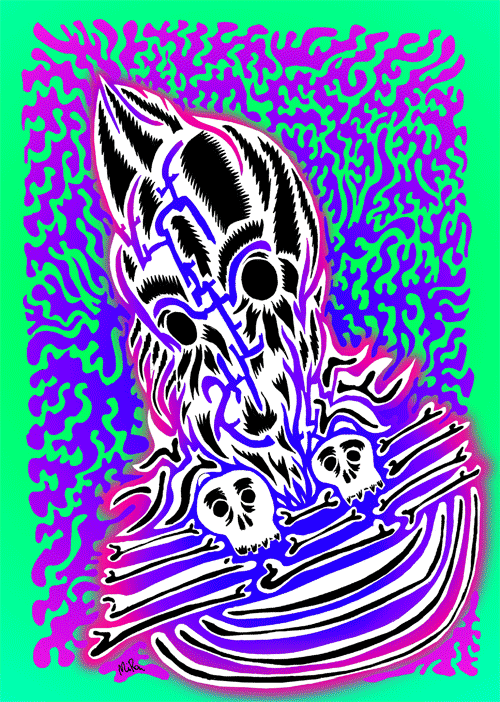
Animation by MiRon
Yuriy MiRonoff, who goes by the name MiRon online, is an artist based in Ukraine who makes some of my favorite GIFs. MiRon GIFs look a bit like animated technicolor GIF versions of Keith Haring’s subway drawings. Like Haring, MiRonoff is putting his work out for the public to see, without any traditional gatekeepers. And, like Haring, he’s quickly become celebrated in mainstream press for his work. MiRonoff even cites Haring and Jean-Michel Basquiat as major influences. Like a piece of street art, a MiRon GIF on your Tumblr feed is going to stop you in your tracks, at least for a moment. Then, you can move on. You don’t need any added context for the work, and it’s all available to see for free online. But unlike photos of street art, which one could argue are showing something one-layer removed from what it really is, Tumblr is the natural environment for MiRonoff’s work, just like it is for INSA’s GIFs. But instead of taking his art to a wall on the streets of Kiev and then taking a photo to post to Tumblr, he’s gone direct to the global audience and made work specifically tailored to that environment, the public space of a new generation.

Animation by Patakk
Paolo Čerić, who goes by the name Patakk, is an artist in his early 20’s based in Croatia, but he’s already one of the most well-known GIF artists in the world. His animations can get thousands of “notes” on Tumblr (the number of reblogs + the number of likes = the number of notes for a post). It seems that people just love to share his mesmerizing GIFs. Patakk’s images aren’t really the sort of thing that you could turn into a poster as easily as MiRonoff’s work, but the same ideas about distributing art direct to the public still apply, and it might be said that Čerić’s work fits even more naturally in Tumblr since his GIFs could not be as effectively recreated as a static image.
Of course, I’ve specifically picked two out of a large group of artists making GIFs and there are probably plenty of GIF artists living in Brooklyn, but I find it particularly cool that these two GIF artists with global followings aren’t located in New York City. With street art and graffiti (before the internet especially), it was easy to bypass local art gatekeepers, but if you were the biggest thing on the streets of Philadelphia, that might not translate to anything in New York City and vice versa. Now, GIF artists are playing in a global public space and location hardly matters as long as you have a stable internet connection and access to a computer with some GIF-making software (admittedly, a barrier to entry for many people, but it’s still a step in the right direction). The playing field really is wide open. Just as a street artist can pick up her first stencil and can of paint and put work on the street the very same day, GIFs can be created in a few minutes by people with no prior experience and go viral almost instantly.
GIF artists are producing work with the same sort of mainstream appeal as street art. The most popular GIF artists aren’t doing conceptual GIFs that require a thesis to understand. They’re making art that is immediately eye-catching, rife with up-to-the-minute cultural references and often easily appropriated by other GIF artists for use in their own work. In 2013, the logical place for the kid who might have picked up a spray can or designed some stickers seems to be Tumblr and the logical thing to make seems to be animated GIFs.